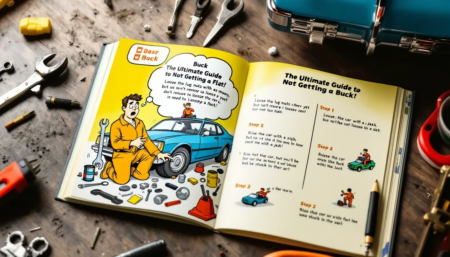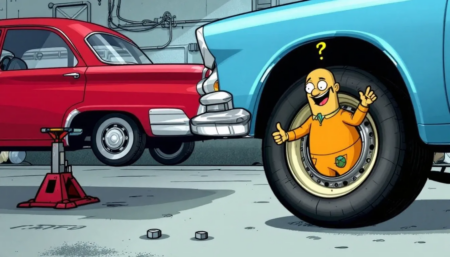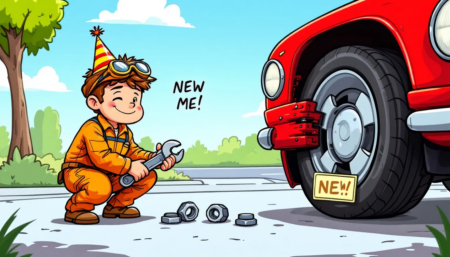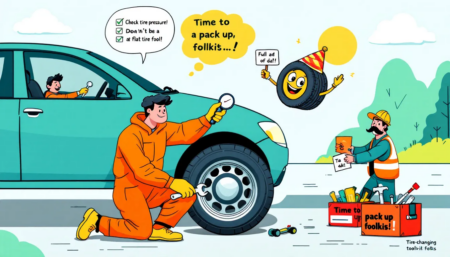How to Change a Tyre in 10 Simple Steps
Facing a flat tyre? No problem. This article shows you how to change a tyre in 10 simple steps, so you can get back on the road quickly and safely.
Key Takeaways
- Ensure safety by parking on flat ground, using hazard lights, and maintaining a safe distance from traffic.
- Gather essential tools like a jack, wheel wrench, and spare tyre, and check their condition before starting.
- Follow a systematic approach: loosen wheel nuts, lift the car, replace the tyre, and check the pressure for a secure fit.
Safety First

Safety is paramount when dealing with car trouble, especially on the roadside. Start by parking your car on a flat surface, well away from traffic. Turn off the engine, apply the handbrake, and shift the car into first gear or park to prevent any movement. Always activate your hazard lights to alert other drivers of your situation.
Wear a reflective jacket to increase your visibility and place a warning triangle at a safe distance behind your vehicle to alert other drivers. Removing passengers from the car and keeping them at a safe distance ensures everyone’s safety.
Make sure your jack is in good working condition and avoid placing any part of your body under the car while it is raised. Being prepared ensures your safety.
Gather Essential Equipment
The right tools are essential for a smooth tyre change. You’ll need a jack, a wheel wrench with an extension bar, a spare tyre, wheel chocks, your car’s manual, and a tyre pressure gauge. These items prepare you for the task ahead.
It’s also wise to keep a tyre repair kit and a locking wheel-nut adapter in your vehicle. These are helpful, especially if your car has locking wheel nuts. Always check that all necessary tools are present, particularly if you bought your vehicle second-hand.
Prepare the Car

Properly preparing your car is crucial before changing a tyre. Apply the handbrake and put the car in first gear or park to prevent movement. Remove all passengers to ensure a safe working environment.
Collect all necessary tools, including the spare wheel from the boot. Refer to your car manual to understand specific instructions and the locations of jacking points.
Secure with Wheel Chocks
Wheel chocks prevent your vehicle from rolling while you change a tyre. Place them behind the wheel diagonally opposite to the one being changed. This extra safety measure keeps the car stable.
If you don’t have wheel chocks, you can use heavy objects like large rocks as a temporary solution. Properly securing your vehicle gives you peace of mind and prevents accidents.
Loosen the Wheel Nuts
Loosen the wheel nuts by turning them anti-clockwise with a wheel wrench while the car is still on the ground. This initial step makes it easier to remove the nuts later when the car is elevated.
Loosen the wheel nuts just enough to turn them by hand later, but don’t remove them completely at this stage. This ensures you can lift the car without additional struggle.
Jack Up the Car

Find your car’s jacking points as indicated in the manual. Position the jack for stability, and consider using a solid plank of wood under the jack for extra support.
Raise the car until the flat tyre is about 10-15 cm off the ground. Make sure the jack is stable and the car is at the correct height for a smooth tyre change.
Remove the Flat Tyre
Once the car is elevated, fully remove the loosened wheel nuts from the flat tyre. Carefully pull the flat tyre towards you to detach it from the hub bolts. If it doesn’t come off easily, replace the wheel nuts and seek assistance.
Detaching the flat tyre is a crucial step in the tyre-changing process.
Install the Spare Tyre
Align the spare tyre accurately with the protruding hub bolts for a secure fit. Slide the spare wheel onto the hub, ensuring the wheel bolts match up correctly.
Hand-tighten the wheel nuts to secure the spare tyre in place. Proper fit and alignment are essential for safe driving.
Lower the Car and Tighten Wheel Nuts

Lower the car slightly with the jack until the spare tyre touches the ground. Use the wheel wrench to tighten the nuts in a star pattern to distribute pressure evenly. Double-check that all nuts are secure.
This step guarantees the spare tyre is properly installed and safe for driving.
Check Tyre Pressure and Pack Up

Check the spare tyre’s pressure with a tyre gauge. Inflate it to the recommended pressure as per your car’s handbook if needed.
After changing the tyre, pack all tools and equipment back into the boot. If you’re using a space-saving wheel, repair or replace the punctured tyre as soon as possible.
Summary
Changing a tyre is a valuable skill that enhances your safety and independence on the road. By following these steps, you can handle car trouble with confidence and efficiency.
Being prepared with the right tools and knowledge is crucial. Always prioritise safety, from parking on a flat surface to using a reflective jacket and warning triangle.
Now that you’re equipped with this guide, practice changing a tyre in a safe environment. This will ensure you’re ready for any car trouble that comes your way.
Frequently Asked Questions
What should I do if I don’t have a reflective jacket or warning triangle?
You can stay safe by moving your vehicle to a secure spot away from traffic and turning on your hazard lights to alert other drivers. Remember, prioritizing your safety is key!
How do I know if my spare tyre is in good condition?
Your spare tyre is in good condition if you regularly check its pressure and look for any visible damage. Stay proactive and ensure your safety by keeping it in top shape!
Can I use a space saver spare wheel for long distances?
You should avoid using a space saver spare wheel for long distances, as they are designed for temporary use only. Prioritize repairing or replacing your punctured tire to ensure your safety and vehicle performance!
What if the flat tyre does not come off easily?
If the flat tyre doesn’t come off easily, don’t force it; instead, re-tighten the wheel nuts and get professional help to avoid any damage. You’ve got this!
Is it necessary to check the tyre pressure after changing a tyre?
Absolutely, checking the tyre pressure after changing a tyre is crucial for your safety on the road. Always use a tyre pressure gauge to ensure it’s at the recommended level!
